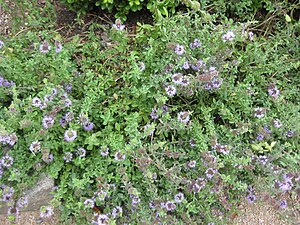Note: This is a project under development. The articles on this wiki are just being initiated and broadly incomplete. You can Help creating new pages.
Hedeoma pulegioides - American pennyroyal
Pudding grass, commonly (European) pennyroyal, also called squaw mint, mosquito plant and Mentha pulegium, is a species of flowering plant in the family Lamiaceae native to Europe, North Africa, and the Middle East. Crushed pennyroyal leaves exhibit a very strong fragrance similar to spearmint. Pennyroyal is a traditional culinary herb, folk remedy, and abortifacient. The essential oil of pennyroyal is used in aromatherapy, and is also high in pulegone, a highly toxic volatile organic compound affecting liver and uterine function.
Contents
Uses
- Pennyroyal was commonly used as a cooking herb by the Greeks and Romans. The ancient Greeks often flavored their wine with pennyroyal.
- Pennyroyal is used to make herbal teas, which, although not proven to be dangerous to healthy adults in small doses, is not recommended, due to its known toxicity to the liver.
- It has been traditionally employed as an emmenagogue (menstrual flow stimulant) or as an abortifacient.
- Pennyroyal is also used to settle an upset stomach and to relieve flatulence.
- The fresh or dried leaves of pennyroyal have also been used when treating colds, influenza, abdominal cramps, and to induce sweating, as well as in the treatment of diseases such as smallpox and tuberculosis, and in promoting latent menstruation.
Common name
- English - pudding grass
Habit
Identification
Leaf
| Kind | Shape | Feature |
|---|---|---|
| Simple | Opposite | The opposite leaves are about 1" long and ¼" across; they are elliptic, oblong-lanceolate, or oblong-oblanceolate in shape. The margins of the leaves are smooth or they have a few blunt teeth toward their tips. The petioles of the leaves are short and slender. The leaves have a strong medicinal-mint scent. |
Flower
| Type | Size | Color and composition | Stamen | More information |
|---|---|---|---|---|
| Bisexual | Verticillaster | White or violet | 2 | Small axillary clusters of 1-4 flowers are produced from the base of each middle to upper leaf. Each flower is about ¼" long and half as much across, consisting of a 2-lipped tubular corolla, a tubular calyx with 5 teeth, 2 stamens, and a 4-celled ovary with a single style. The corolla is white or blue-violet with a contrasting color near its throat. Along the outer rim of the corolla, there is an upper lobe, 2 lateral lobes, and a lower lobe; they are short and rounded (although not always well-defined). The hairy ridged calyx has 3 upper triangular teeth and 2 lower teeth that are slender-lanceolate. |
Fruit
| Type | Size | Mass | Appearance | Seeds | More information |
|---|---|---|---|---|---|
| Nutlet | At maturity, each fertile flower is replaced by 4 nutlets | This wildflower reproduces by reseeding itself. It occasionally forms colonies at favorable sites | {{{6}}} |
Other features
List of Ayurvedic medicine in which the herb is used
Where to get the saplings
Mode of Propagation
How to plant/cultivate
Pennyroyal can be propagated from seed, cuttings or spring division. The seed needs light to germinate but grows quickly once it sprouts. Plant them in prepared seed beds outside after all danger of frost. Sow the seed on the surface of the soil and mist the bed to moisten it. Keep it moist and germination should occur in two weeks. [2]
Season to grow
Soil type
Propagation
Commonly seen growing in areas
Photo Gallery
References
- ↑ https://www.illinoiswildflowers.info/woodland/plants/am_pennyroyal.htm "Plant description"]
- ↑ <ref name="Leaf">https://www.illinoiswildflowers.info/woodland/plants/am_pennyroyal.htm "Leaf"]



